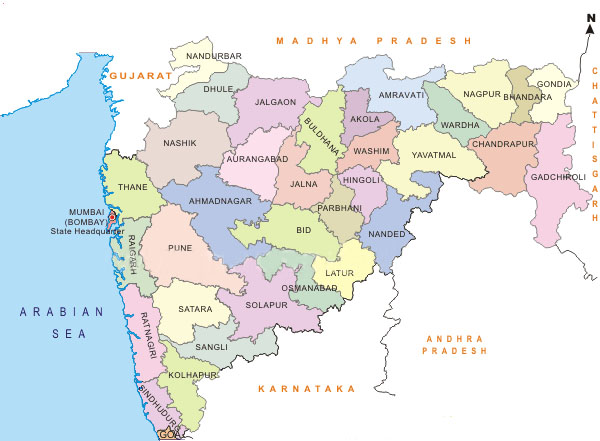
Language and Literature (Chapter III)
Marathi Language
Marathi (मराठी Marāṭhī) is an Indo-Aryan language spoken by the Marathi people of western India. It is the official language of the state of Maharashtra. There are 90 million fluent speakers worldwide. Marathi is the 4th most spoken language in India and the 15th most spoken language in the world. Marathi is the oldest of the regional literatures in Indo-Aryan languages, dating from about AD 1000.
Marathi is estimated to be more than 1300 years old, evolving from Sanskrit through Prakrit and Apabhramsha. Its grammar and syntax derive from Pali and Prakrit. In ancient times, Marathi was called Maharashtri, Marhatti, Mahratti etc.
Peculiar features of Marathi linguistic culture include Marathi drama, with its unique flavour of 'Sangeet Natak' (musical dramas), scholarly discourses called 'Vasant Vyakhyanmala' (Lectures in Spring), Marathi folk dance called 'Lavani', and special editions of magazines for Diwali called 'Diwali anka'.
Marathi literature
The Prakrit vernacular languages, including Maharashtri Prakrit, were originally derived from Vedic Sanskrit. Further change led to apabhraṃśa languages like Marathi, which may be described as being a re-Sanskritised, developed form of Maharashtri Apabhraṃśa. However it is believed that Marathi is actually a language combining the old Dravidian vernacular of the region which would have been close to Kannada and Telugu and the actual Maharashtri Prakrit and Sanskrit. The more recent influence of Persian, Arabic or Urdu has also made this language seem close to mainstream Hindi.
Maharashtri Prakrit was commonly spoken until 875 AD and was the official language of the Sātavāhana empire. It had risen to a high literary level, and works like Karpurmanjari and Saptashati (150 BC) were written in it. Maharashtri Prakrit was the most widely used Prakrit language in western and southern India, spoken from Malwa and Rajputana in the north to Krishna and Tungabhadra in the south. Today's Marathi- and Kannada- speaking parts spoke Maharashtri Prakrit for centuries.
Maharashtri Apabhraṃśa remained in use for several hundred years until at least 500 AD. Apabhraṃśa was used widely in Jain literature and formed an important link in the evolution of Marathi. This form of Apabhraṃśa was re-Sanskritised and eventually became Marathi.
According to the written forms and historical attestations and evidences, Marathi is said to date to the 8th century.
The first written attestation of Marathi, a document found in Karnataka, dates from 700 AD. The earliest known written form is on the copperplate of Vijayaditya found in Satara, dated 739 AD.
The stone inscription at the feet of Shravanabelagola Gomateshwar in South Karnataka, whose first line reads as "Chavundarajen Karaviyalen" (श्रीचावुण्डराजे करवियले, श्रीगंगराजे सुत्ताले करवियले, meaning Built by Chavundaraja, the son of Gangaraja), is another old specimen, constructed in 983 AD.
Also, an interesting couplet is found in the Jain monk Udyotan Suri's Kuvalayamala in the 8th century, referring to a bazaar where the Marhattes speak Didhale (Dile - given), Gahille (Ghetale - taken). The Marathi translation of Panchatantra is also considered very old.
By 983, therefore, Marathi was one of the distinctly different current languages widely used by the people of the area from North Maharashtra to South Karnataka. Six extant inscriptions dating from 979 to 1270 and placed in distant parts like Mysore, Khandesh and Mumbai are an index of the large area over which Marathi was spoken.
It is because the language was spoken so widely that the deeds of charitable gifts like the one at Patan recording the maintenance grants given by King Soidev to Changdev's University and the imperial mandates expected to be obeyed by all, like the Edict of King Aparaditya (1183), were inscribed in Marathi. The Pandharpur inscription (1273) of the days of Raja Shiromani Ramdev Rao is in flawless Marathi. Marathi was now spoken by all classes and castes.
Marathi literature began and grew thanks to the rise of both the Yadava dynasty of Devgiri (who adopted Marathi as the court language and patronized Marathi scholars) and two religious sects - Mahanubhav Panth and Warkari Panth, who adopted Marathi as the medium for preaching their doctrines of devotion. Marathi had attained a venerable place in court life by the time of the Yadava kings. During the reign of the last three Yadava kings, a great deal of literature in verse and prose, on astrology, medicine, Puranas, Vedanta, kings and courtiers were created. Nalopakhyan, Rukmini swayamvar and Shripati's Jyotishratnamala (1039 AD) are a few examples.
The oldest book in prose form in Marathi, Vivekasindhu (विवेकसिंधु), was written by Mukundaraj, a yogi of Natha Pantha and arch-poet of Marathi. Mukundaraj bases his exposition of the basic tenets of the Hindu philosophy and Yoga Marga on the utterances or teachings of Shankaracharya. Mukundaraj's other work, Paramamrita, is considered the first systematic attempt to explain the Vedanta in the Marathi language. One of the famous saints of this period is Sant Dnyaneshwar (1275–1296) who wrote Bhavarthadeepika, popularly known as Dnyaneshwari (1290), and Amritanubhava.
He also composed devotional songs called abhangas. Dnyaneshwar gave a higher status to Marathi by bringing the sacred Bhagavad Gita from Sanskrit to Marathi.


Hey very interesting blog!
ReplyDeleteI'm really impressed with your writing skills and also with the layout on your blog.
ReplyDeleteIs this a paid theme or did you modify it yourself?
Either way keep up the excellent quality writing, it is rare to see a great blog like this one today.